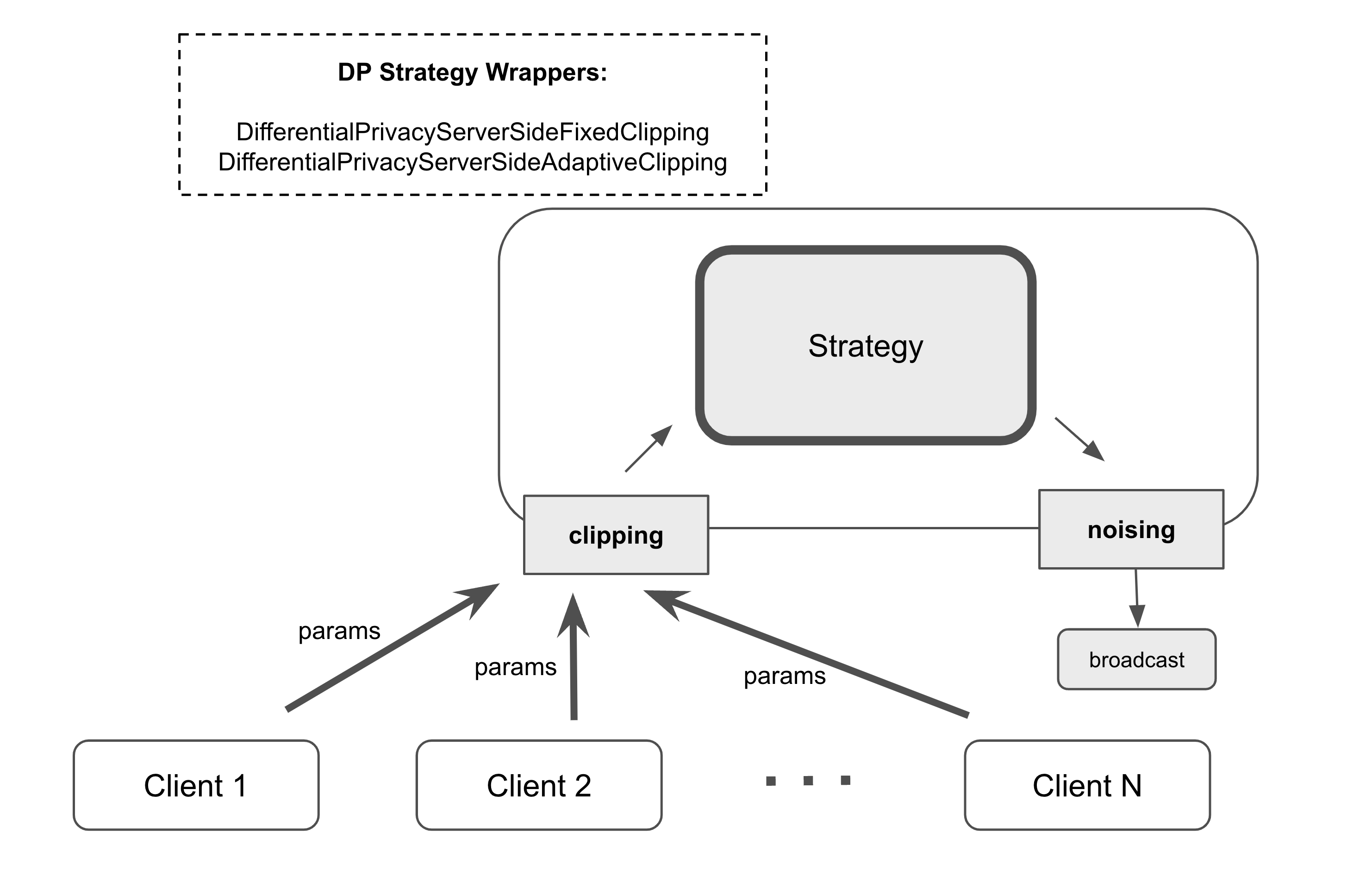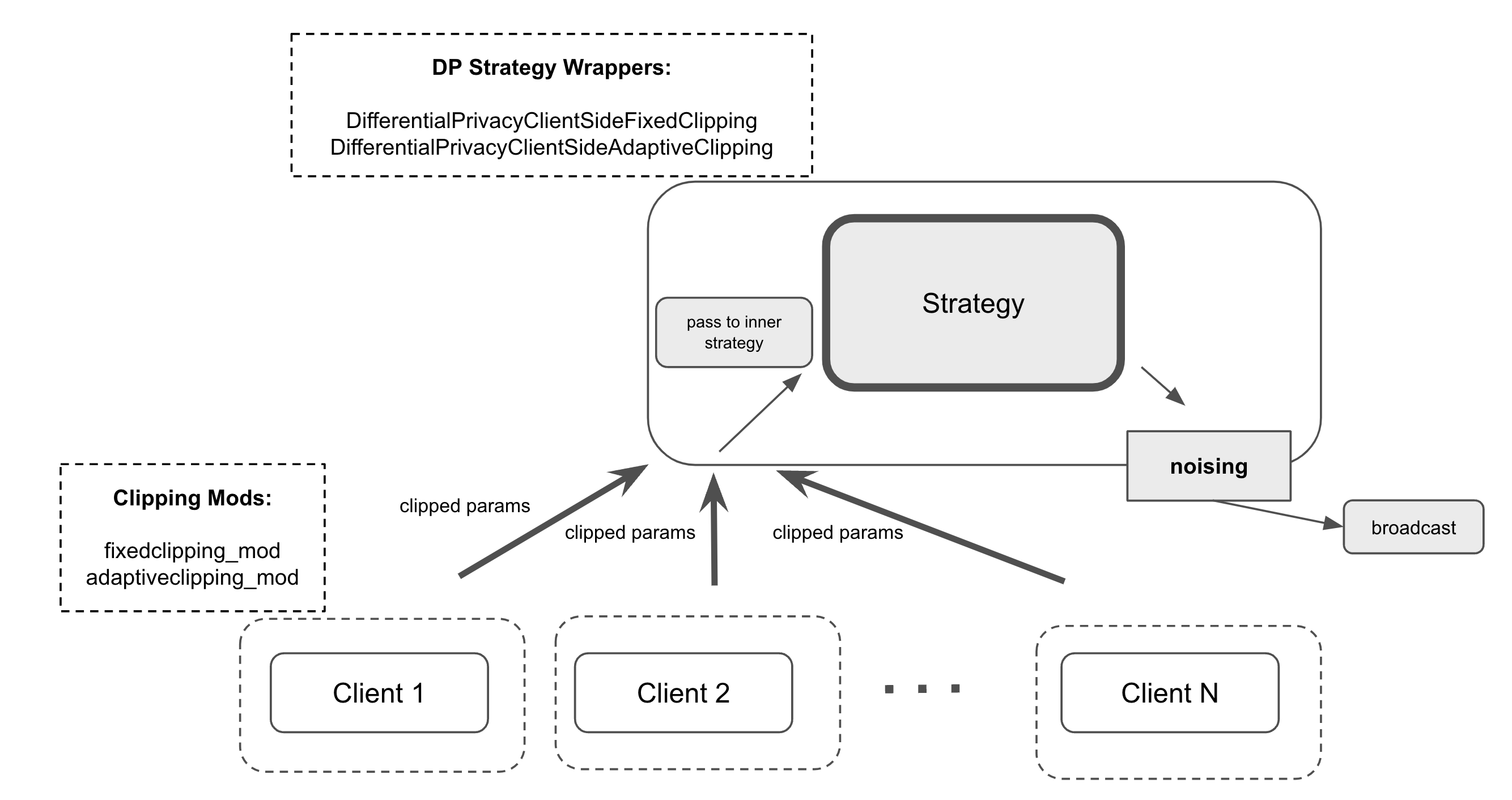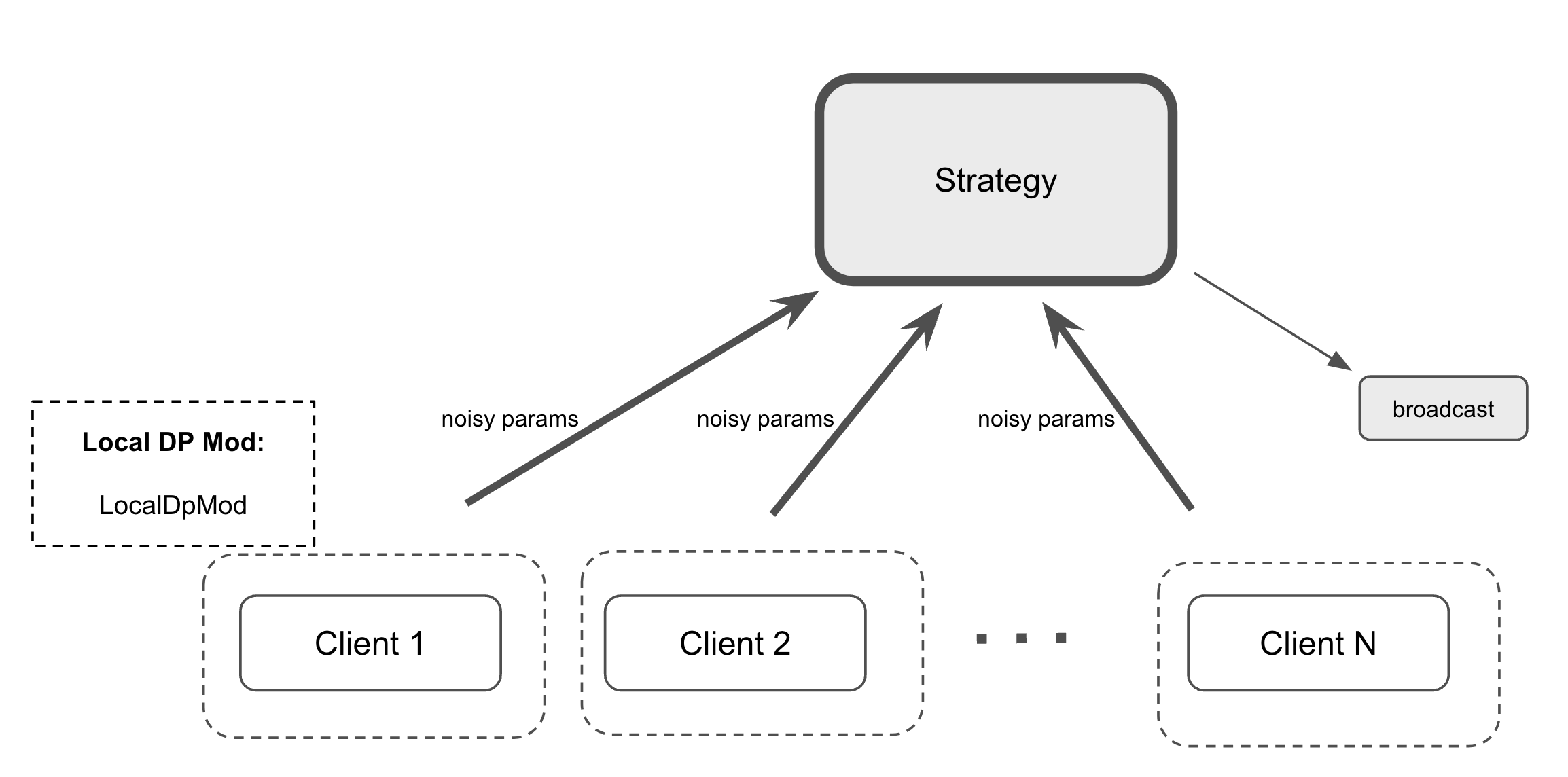차분 개인정보 보호 사용¶
이 가이드에서는 Flower 프레임워크에서 차분 개인정보 보호 기능을 활용하는 방법을 설명합니다. 차분 개인정보 보호에 대해 아직 익숙하지 않은 경우 :doc:`explanation-differential-privacy`를 참조하세요.
경고
Flower의 차분 개인정보 보호는 현재 프리뷰 단계에 있습니다. 민감한 데이터가 있는 프로덕션 환경에서 이러한 기능을 사용할 계획이라면 언제든지 문의하여 요구 사항을 논의하고 이러한 기능을 가장 잘 사용하는 방법에 대한 안내를 받으세요.
중앙 차등 프라이버시¶
This approach consists of two separate phases: clipping of the updates and adding noise to the aggregated model. For the clipping phase, Flower framework has made it possible to decide whether to perform clipping on the server side or the client side.
Server-side Clipping: 이 방식은 서버가 모든 클라이언트의 업데이트에 대해 균일한 클리핑을 적용하고 클리핑 값에 대한 통신 오버헤드를 줄일 수 있다는 장점이 있습니다. 하지만 모든 클라이언트에 대해 클리핑 작업을 수행해야 하기 때문에 서버의 계산 부하가 증가한다는 단점도 있습니다.
Client-side Clipping: 이 방식은 서버의 계산 오버헤드를 줄일 수 있다는 장점이 있습니다. 하지만 서버가 클리핑 프로세스에 대한 통제력이 떨어지기 때문에 centralized 제어가 부족하다는 단점도 있습니다.
서버 측 클리핑¶
For central DP with server-side clipping, there are two Strategy classes that act as
wrappers around the actual Strategy instance (for example, FedAvg). The two
wrapper classes are DifferentialPrivacyServerSideFixedClipping and DifferentialPrivacyServerSideAdaptiveClipping for fixed and adaptive
clipping.

The code sample below enables the FedAvg strategy to use server-side fixed clipping
using the DifferentialPrivacyServerSideFixedClipping wrapper class. The same
approach can be used with DifferentialPrivacyServerSideAdaptiveClipping by adjusting
the corresponding input parameters.
from flwr.serverapp.strategy import DifferentialPrivacyClientSideFixedClipping, FedAvg
# Create the strategy
strategy = FedAvg(...)
# Wrap the strategy with the DifferentialPrivacyServerSideFixedClipping wrapper
dp_strategy = DifferentialPrivacyServerSideFixedClipping(
strategy,
cfg.noise_multiplier,
cfg.clipping_norm,
cfg.num_sampled_clients,
)
클라이언트 측 클리핑¶
For central DP with client-side clipping, the server sends the clipping value to
selected clients on each round. Clients can use existing Flower Mods to perform the
clipping. Two mods are available for fixed and adaptive client-side clipping:
fixedclipping_mod and adaptiveclipping_mod with corresponding
server-side wrappers DifferentialPrivacyClientSideFixedClipping and DifferentialPrivacyClientSideAdaptiveClipping.

The code sample below enables the FedAvg strategy to use differential privacy with
client-side fixed clipping using both the DifferentialPrivacyClientSideFixedClipping
wrapper class and, on the client, fixedclipping_mod:
from flwr.serverapp.strategy import DifferentialPrivacyClientSideFixedClipping, FedAvg
# Create the strategy
strategy = FedAvg(...)
# Wrap the strategy with the DifferentialPrivacyClientSideFixedClipping wrapper
dp_strategy = DifferentialPrivacyClientSideFixedClipping(
strategy,
cfg.noise_multiplier,
cfg.clipping_norm,
cfg.num_sampled_clients,
)
In addition to the server-side strategy wrapper, the ClientApp needs to configure
the matching fixedclipping_mod to perform the client-side clipping:
from flwr.clientapp import ClientApp
from flwr.clientapp.mod import fixedclipping_mod
# Add fixedclipping_mod to the client-side mods
app = ClientApp(mods=[fixedclipping_mod])
로컬 차등 프라이버시¶
To utilize local differential privacy (DP) and add noise to the client model parameters
before transmitting them to the server in Flower, you can use the LocalDpMod.
The following hyperparameters need to be set: clipping norm value, sensitivity, epsilon,
and delta.

Below is a code example that shows how to use LocalDpMod:
참고
Apply the mod only to the functions that require it. For example, to use local DP
during training, add the mod to the training function with
@app.train(mods=[your_mod]). Avoid adding it directly to ClientApp with
ClientApp(mods=[your_mod]), as this applies the mod to all functions (including
evaluation), which is generally unnecessary and error-prone.
from flwr.clientapp import ClientApp
from flwr.clientapp.mod import LocalDpMod
# Initialize the client app
app = ClientApp()
# Create an instance of the mod with the required params
local_dp_obj = LocalDpMod(cfg.clipping_norm, cfg.sensitivity, cfg.epsilon, cfg.delta)
# Add the mod to your training function
@app.train(mods=[local_dp_obj])
def train(message, context):
# Client-side training logic
...
여러 개의 수정자를 사용할 때는 수정자, 특히 매개변수를 수정하는 수정자의 순서가 중요하다는 점에 유의하세요. 일반적으로 차분 프라이버시(DP) 수정자는 매개변수에서 가장 마지막에 작동해야 합니다.
Privacy Engines을 사용한 로컬 훈련¶
For ensuring data instance-level privacy during local model training on the client side, consider leveraging privacy engines such as Opacus. For examples of using Flower with these engines, please refer to the Flower examples directory (Opacus).